
Pentatomidae is a family of insects belonging to the order Hemiptera, generally called shield bugs or stink bugs. Pentatomidae is the largest family in the superfamily Pentatomoidea, and contains around 900 genera and over 4700 species. As hemipterans, the pentatomids have piercing sucking mouthparts, and most are phytophagous, including several species which are severe pests on agricultural crops. However, some species, particularly in the subfamily Asopinae, are predatory and may be considered beneficial.

Peridroma saucia, the pearly underwing or variegated cutworm, is a moth of the family Noctuidae. The species was first described by Jacob Hübner in 1808. It is found in North and South America, Europe, Asia and Africa. The variegated cutworm feeds on many plants, especially common fruits and vegetables. The moth undergoes two to four generations per year. The development of the moth slows in colder temperatures, indicative of its migratory nature. All stages of the life cycle have a developmental threshold for temperature. The moth is known to migrate to the northern regions during warmer months, returning to the southern regions when the climate becomes colder.
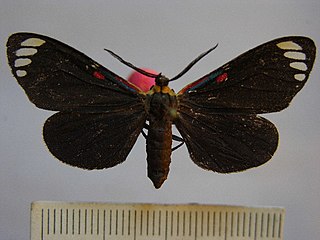
Phaloesia is a monotypic of tiger moth genus in the family Erebidae. Its only species is Phaloesia saucia, the saucy beauty moth. The genus and species were first described by Francis Walker in 1854. It is found from the lower Rio Grande Valley of Texas in the United States to Venezuela.
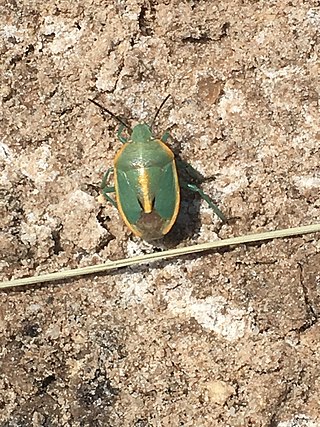
Chlorochroa faceta is a species of stink bug in the family Pentatomidae. It is found in Central America and North America.
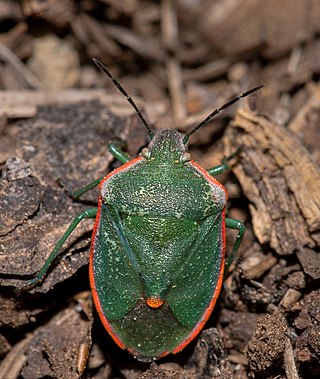
Chlorochroa is a genus of shield (stink) bugs in the family Pentatomidae, found in Europe and North America. There are over 20 described species in Chlorochroa.
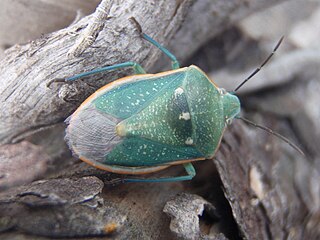
Chlorochroa sayi, or Say's stink bug, is a species of stink bug in the family Pentatomidae. It is found in North America.

Chlorochroa senilis is a species of stink bug in the family Pentatomidae. It is found in North America.

Chlorochroa uhleri, or Uhler's stink bug, is a species of stink bug in the family Pentatomidae. It is found in Central America and North America.
Chlorochroa belfragii is a species of stink bug in the family Pentatomidae. It is found in North America.

Chlorochroa ligata, the conchuela bug, is a species of stink bug in the family Pentatomidae. It is found in Central America and North America.
Chlorochroa opuntiae is a species of stink bug in the family Pentatomidae. It is found in North America.
Chlorochroa osborni is a species of stink bug in the family Pentatomidae. It is found in Central America and North America.
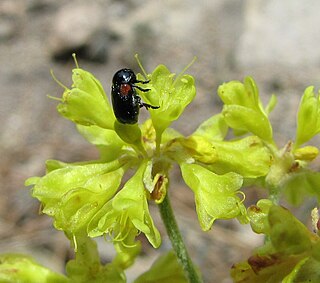
Saxinis saucia is a species of case-bearing leaf beetle in the family Chrysomelidae. It is found in Central America and North America.
Chlorochroa lineata is a species of stink bug in the family Pentatomidae. It is found in North America.
Chlorochroa kanei is a species of stink bug in the family Pentatomidae. It is found in North America.
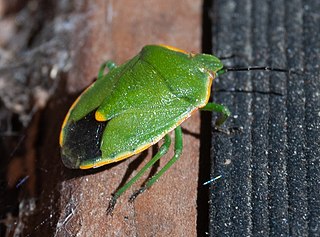
Chlorochroa rossiana is a species of stink bug in the family Pentatomidae. It is found in North America.
Chlorochroa granulosa is a species of stink bug in the family Pentatomidae. It is found in North America.
Aradus implanus is a species of flat bug in the family Aradidae. It is found in North America.
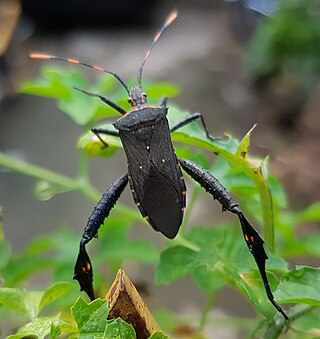
Leptoglossus gonagra, known as the passionvine bug, citron bug or squash bug in different parts of its range, is a species of leaf-footed bug in the family Coreidae. It is found in Africa, the Caribbean, Central America, North America, South America, Southern Asia, the Pacific Ocean and Oceania.

Coelophora is a genus of ladybird beetles in the family Coccinellidae. There are about 14 described species in Coelophora.













